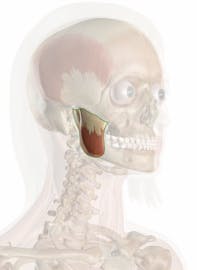Masseter Muscle

The masseter muscle is a thick quadrilateral muscle located in the cheek. It is needed for mastication (chewing) and performs when it closes the jaws. It is made up of two parts: superficial and deep. The larger, superficial portion comes up by a wide tendinous aponeurosis from the zygomatic process of the maxilla, and from the anterior two-thirds of the bottom lower border and deep surface of the zygomatic arch. Its fibers extend down and back and fit into the angle and bottom half of the lateral surface of the ramus of the mandible.
The second part, the deep portion, is a lot smaller and has a texture that is more muscular. This part comes from the posterior third of the lower border and by way of the whole of the medial surface of the zygomatic arch. The fibers go down and forward and fit into the top half of the ramus and the lateral surface of the coronoid process of the mandible. This portion of the masseter muscle is only partially covered by the superficial portion in front. It is concealed by the parotid gland behind. The fibers of both the deep and superficial portions are continuous at their insertion.
The masseter lifts the mandible and assists in protracting it. The nerve comes from the mandibular nerve. The name for this muscle means the chewer muscle.


